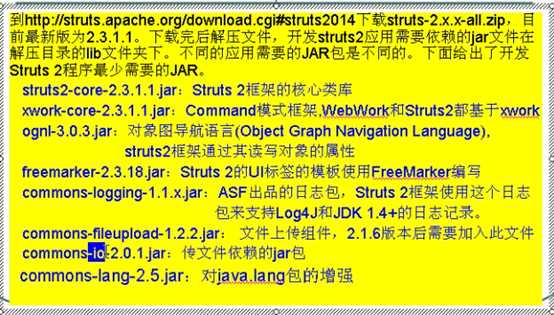标签:
搭建struts2环境时,我们一般需要做一下几个步骤的工作:
1、 创建javaweb工程
2、 找到开发struts应用所需要使用的jar
3、 创建jsp文件
4、 创建action文件
5、 编写struts2的配置文件
6、 在web.xml中加入struts2 MVC框架启动配置
开发struts2中需要使用的基本jar包:


我的myeclipes默认的struts2提示只到2.1,如果需要有2.3的提示,有两种情况:
1、 电脑可以连接外网:
在perference下面找xml,找到xml-catalog,选择User Specified Entries,add:
Location填入dtd声明中的http-那行也就是第二行,key填入第一行。外网会自动下载即可。
2、 电脑不可以连接外网:
将struts2.3的dtd解压防止在本地磁盘,不能有中文路径和空格,add中选择file system,其他不变。Location就是本地路径。
得到action我们有大概两种方式:
1、 类实现Action接口,至于什么jar就不多说了
2、 类继承自ActionSupport类
package cn.itcast.action; import com.opensymphony.xwork2.ActionSupport; /* public class HelloWorldAction implements Action { public String execute() throws Exception { System.out.println("this is HelloWorldAction execute method!"); return "success"; } } */ public class HelloWorldAction extends ActionSupport{ /** * */ private static final long serialVersionUID = 1L; public String execute() throws Exception { System.out.println("this is HelloWorldAction execute method 2!"); return "success"; } }
书写struts.xml:
<?xml version="1.0" encoding="UTF-8" ?> <!DOCTYPE struts PUBLIC "-//Apache Software Foundation//DTD Struts Configuration 2.3//EN" "http://struts.apache.org/dtds/struts-2.3.dtd"> <!-- 书写配置文件找dtd,打开webApp,找到struts2.core下的2.3.dtd,直接复制这部分即可 --> <struts> <!-- package:包 name:包名,唯一的,必选项 namespace:命名空间,唯一的,相当于房间号。可选项,省略情况下是“/” extends:继承 extends=“struts-default”:struts2框架底层提供的核心包struts2-core-2.3.3.jar下的struts-default.xml文件 为什么要继承这个struts-default.xml文件 因为struts框架底层提供的struts-default.xml声明了所有的拦截器和拦截器栈。 我们知道struts2框架运行时执行struts-default.xml中的拦截器栈完成必要功能。 如果不继承struts-default.xml文件,就没有办法使用struts2提供的所有拦截器。 --> <!-- 动态方法调用 --> <constant name="struts.enable.DynamicMethodInvocation" value="true" /> <!-- 开发者模式 --> <constant name="struts.devMode" value="true" /> <package name="one" namespace="/prima" extends="struts-default"> <!-- action: name:对应页面请求链接的后面半部分 class:对应要执行的类的完整路径 --> <action name="userAction" class="cn.itcast.action.UserAction"> <!-- result:结果类型 name:对应的是执行的类的方法的返回值 后半部分文本内容:转向的页面 --> <result name="success">/success.jsp</result> </action> </package> <package name="two" namespace="/helloworld" extends="struts-default"> <action name="helloWorldAction" class="cn.itcast.action.HelloWorldAction"> <result name="success">/success.jsp</result> </action> </package> </struts>
配置struts2核心过滤器:
<filter>
<filter-name>struts2</filter-name>
<filter-class>org.apache.struts2.dispatcher.ng.filter.StrutsPrepareAndExecuteFilter</filter-class>
</filter>
<filter-mapping>
<filter-name>struts2</filter-name>
<url-pattern>/*</url-pattern>
</filter-mapping>
补充一些代码,可以自行拼接第一个struts程序:

package cn.itcast.action; import com.opensymphony.xwork2.Action; public class UserAction implements Action { public String execute() throws Exception { System.out.println("this is userAction execute method!"); return "success"; } }

<%@ page language="java" import="java.util.*" pageEncoding="UTF-8"%> <% String path = request.getContextPath(); String basePath = request.getScheme()+"://"+request.getServerName()+":"+request.getServerPort()+path+"/"; %> <!DOCTYPE HTML PUBLIC "-//W3C//DTD HTML 4.01 Transitional//EN"> <html> <head> <base href="<%=basePath%>"> <title>My JSP ‘test.jsp‘ starting page</title> <meta http-equiv="pragma" content="no-cache"> <meta http-equiv="cache-control" content="no-cache"> <meta http-equiv="expires" content="0"> <meta http-equiv="keywords" content="keyword1,keyword2,keyword3"> <meta http-equiv="description" content="This is my page"> <!-- <link rel="stylesheet" type="text/css" href="styles.css"> --> </head> <body> 入门程序:<br/> <a href="${pageContext.request.contextPath}/prima/userAction.action">userAction</a><br/> <a href="${pageContext.request.contextPath }/helloworld/helloWorldAction.action">helloWorld</a> </body> </html>

<%@ page language="java" import="java.util.*" pageEncoding="UTF-8"%> <% String path = request.getContextPath(); String basePath = request.getScheme()+"://"+request.getServerName()+":"+request.getServerPort()+path+"/"; %> <!DOCTYPE HTML PUBLIC "-//W3C//DTD HTML 4.01 Transitional//EN"> <html> <head> <base href="<%=basePath%>"> <title>My JSP ‘success.jsp‘ starting page</title> <meta http-equiv="pragma" content="no-cache"> <meta http-equiv="cache-control" content="no-cache"> <meta http-equiv="expires" content="0"> <meta http-equiv="keywords" content="keyword1,keyword2,keyword3"> <meta http-equiv="description" content="This is my page"> <!-- <link rel="stylesheet" type="text/css" href="styles.css"> --> </head> <body> this is success.jsp! <br> </body> </html>
标签:
原文地址:http://www.cnblogs.com/aigeileshei/p/5886285.html